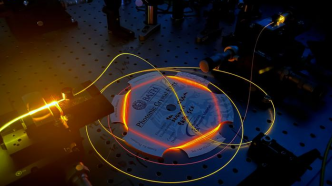
Researchers at the Austrian Institute of Science and Technology, the Vienna University of Technology and the Technical University of Munich in Germany published a paper in the latest issue of the journal Science, saying that they have entangled low-energy microwaves with high-energy optical photons for the first time. This entangled quantum state of two photons is the basis for connecting superconducting quantum computers via room-temperature links, which has major implications for scaling existing quantum hardware, enabling interconnections with other quantum computing platforms, and for novel quantum-enhanced remote sensing applications. Influence.
A single microwave photon is actually an information carrier between superconducting qubits within a processor, and is not suitable for sending between processors at room temperature. Because heat can destroy quantum properties such as entanglement, qubits cannot be calculated. Because of this, in order to remain functional, a quantum computer must isolate the qubits from the environment, cooling them to extremely low temperatures in a vacuum.
For superconducting qubits, they work with tiny electric currents that move back and forth through the circuit about ten billion times per second. They interact using microwave photons (particles of light). But the problem is that even a small amount of heat can easily interfere with a single microwave photon and its quantum properties.
The researchers used a special electro-optic device: an optical resonator made of a nonlinear crystal that changes its optical properties in the presence of an electric field. A superconducting cavity houses this crystal and enhances this interaction.
They used a laser to send billions of optical photons into an electro-optic crystal within a fraction of a microsecond. In this way, an optical photon splits into a new pair of entangled photons: an optical photon with only a little less energy than the original photon, and a microwave photon with much lower energy. The researchers managed to build a larger superconducting device that not only avoided damage to the superconductivity, but also helped to cool the device more efficiently and keep the temperature low for short durations of optical laser pulses.
The breakthrough, the researchers say, is due to the entanglement of the two photons leaving the device - the optical photon and the microwave photon. They corroborate the new study by measuring the correlation between the quantum fluctuations in the electromagnetic fields of the two photons, which is stronger than classical physics can explain. (Original title "The first entanglement of microwave and optical photons is of great significance to quantum computing related research")

